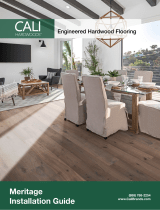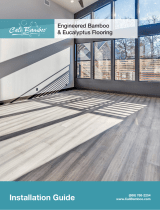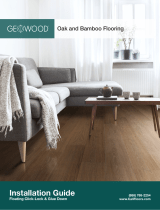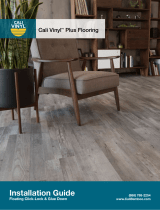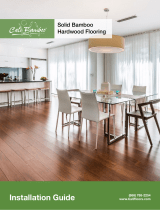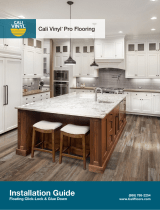Page is loading ...

Columbus, Ohio 43207 614.443.0241 (Technical Service 1.800.347.4583) © 2017 BCM2753 8/17 FF1096
VISIT WWW.TITEBOND.COM FOR THE
MOST UP-TO-DATE PRODUCT INFORMATION
V-notch V-notch (saw tooth) Square-notch
231
SELECT
801
PREFERRED
811
ADVANTAGE
821
STEP
771
STEP
991
PROVANTAGE
Engineered Engineered
Engineered, Parquet,
Solid (5/8” or less)
& Bamboo
Engineered, Parquet,
Solid (5/8” or less)
& Bamboo
Engineered, Parquet,
Solid (5/8” or less)
& Bamboo
Engineered, Parquet,
Solid (5/8” or less)
& Bamboo
APPLICATION RECOMMENDATIONS
N/A N/A
3/16” X 3/16” X 3/16”
Square-notch
(35 sq. ft. per gallon)
3/16” X 3/16” X 3/16”
Square-notch
(35 sq. ft. per gallon)
3/16” X 3/16” X 3/16”
Square-notch
(35 sq. ft. per gallon)
3/16” x 3/16” x 3/16”
Square-notch
(35 sq. ft. per gallon)
SOLID 3” WIDTH OR GREATER - TROWEL/COVERAGE
N/A N/A
1/8” X 1/8” X 1/8”
Square-notch
(65 sq. ft. per gallon)
1/8” X 1/8” X 1/8”
Square-notch
(65 sq. ft. per gallon)
1/8” X 1/8” X 1/8”
Square-notch
(65 sq. ft. per gallon)
1/8” x 1/8” x 1/8”
Square-notch
(65 sq. ft. per gallon)
ALL PARQUETS MEASURING LESS THAN 3/4” THICKNESS - TROWEL/COVERAGE
N/A N/A N/A N/A
1/4” x 3/16” V-notch
(saw tooth)
(35 sq. ft. per gallon)
1/4” x 3/16” V-notch
(saw tooth)
(35 sq. ft. per gallon)
ENGINEERED
(
ADHESIVE, MOISTURE & SOUND CONTROL
)
- TROWEL/COVERAGE
N/A N/A N/A
1/4” x 1/4” V-notch
(saw tooth)
(30 sq. ft. per gallon)
1/4” x 1/4” V-notch
(saw tooth)
(30 sq. ft. per gallon)
N/A
SOLID & BAMBOO UP TO 5/8”
(
ADHESIVE, MOISTURE & SOUND CONTROL
)
- TROWEL/COVERAGE
3/16” x 1/4” x 11/16
V-notch
(65 sq. ft. per gallon)
3/16”w x 1/4”d x 1/2”
c-c (or 5/16” space)
V-notch
(50 sq. ft. per gallon)
3/16”w x 1/4”d x 1/2”
c-c (or 5/16” space)
V-notch
(50 sq. ft. per gallon)
3/16”w x 1/4”d x 1/2”
c-c (or 5/16” space)
V-notch
(50 sq. ft. per gallon)
3/16”w x 1/4”d x 11/16”
c-c (or 1/2” space)
V-notch
(65 sq. ft. per gallon)
3/16”w x 1/4”d x 11/16”
c-c (or 1/2” space)
V-notch
(65 sq. ft. per gallon)
ENGINEERED - TROWEL/COVERAGE
N/A N/A
3/16”w x 1/4”d x 1/2”
c-c (or 5/16” space)
V-notch
(50 sq. ft. per gallon)
3/16”w x 1/4”d x 1/2”
c-c (or 5/16” space)
V-notch
(50 sq. ft. per gallon)
3/16”w x 1/4”d x 1/2”
c-c (or 5/16” space)
V-notch
(50 sq. ft. per gallon)
SOLID 3” WIDTH OR LESS - TROWEL/COVERAGE
3/16” x 1/4” x 1/2”
V-notch
(50 sq. ft. per gallon)

1. GAPS
Problem - Spaces that appear between individual boards.
Cause
• Wood ooring shrinks as it loses moisture
• The installer fails to properly seat a plank
• A oor is sanded before the adhesive has fully dried
• Environmental conditions
Solution - Use humidiers & dehumidiers to control humidity uctuation.
2. CROWNING
Problem - Crowning is where the center of the piece of ooring raises
above the edges. This can be a temporary condition, and if the crowning
is slight, the oor may remain well-anchored. The conditions persist only
if there is a continuous source of moisture being introduced above or
below the oor. Exposure to severe moisture levels, even for short periods
of time, may also result in delamination of the ooring, or cracking or
peeling of the surface nish.
Cause
• Continuous source of moisture being introduced above or below the oor
• Cupping had previously occurred, and ooring was sanded before the
moisture content could return to normal
Solution - Allowing the wood to acclimate on site before it is installed
serves to reduce the growth that occurs after installation, and reduces
the potential for moisture related problems. Taking moisture readings
on the top and bottom of the oor will allow moisture imbalance to be
distinguished from unbalanced construction in the ooring. Once the
moisture levels of the oor and suboor have returned to normal,
re-sand and nish.
3. BUCKLING
Problem - Flooring parting from the suboor due to extreme expansion
caused by excessive moisture. When a oor buckles, there will often be
several feet of ooring along the edge of the room which remain at,
followed by several adjoining rows of ooring which are uplifted in an
inverted “V”. The oor may show signs of rotting, and there may be
mold or mildew present on the wood. When moisture has been introduced
through a concrete slab, there also may be discoloration of some adhesive
types, with a reddish or purple color developing in certain areas.
Cause
• Moisture changes in wood
• Moisture caused by leaking pipes, wet slabs, extreme humidity
• Use of wrong trowel
• Inadequate adhesive use
• Floor runs out of room to expand
Solution - Allowing the wood to acclimate on site before it is installed
serves to reduce the growth which will occur after installation, and
reduces the potential for moisture related problems. It is important to
check the suboor to verify that the moisture level is reasonable before
beginning the job, and to observe the recommended ash times for any
water containing adhesives to minimize the moisture they can contribute
to the oor. Because many moisture-related problems result from poor
drainage outside the building, it may sometimes be wise to recommend
that gutters be installed or drainage improved before a large investment
is made on a wood oor. For damaged oors, reverse the high-moisture
situation and let the oor/suboor dry. Relieve ooring of stress caused
by vertical obstacles (cabinets, walls, etc.). Sometimes repair or individual
replacement is possible, but often a complete replacement is necessary.
4. CUPPING
Problem - The edges of an affected piece of ooring rise above the
center of the piece. This can be a temporary condition, and if the
cupping is slight, the oor may remain well-anchored.
Cause
• Different moisture levels within individual layers of ooring
• Low levels of humidity (referred to as “dry cupping”)
• Rapid drying of oor surface
Solution - Allowing the wood to acclimate on site before it is installed
serves to reduce the growth which will occur after installation, and
reduces the potential for moisture related problems. Taking moisture
readings on the top and bottom of the oor will allow moisture imbalance
to be distinguished from unbalanced construction in the ooring. When
the excessive moisture is removed, the ooring can return to its original
shape, but it could take months. If it does not return to its original shape,
the oor is probably permanently damaged and the edges that are
cupped may be sanded off. Floors may also cup due to rapid drying,
and in this case, it is recommended that humidication be used.
5. ENDLIFTING
Problem - Wood ooring boards look as if they are raised at the end.
Cause
• Incorrect maintenance
• Use of wrong trowel or adhesive
• Mistake during manufacturing
• Inadequate spacing of cleats or staples
• Excessive moisture during installation, adhesive not being able to dry
Solution - If the problems are related to excessive moisture, once the
moisture is removed, the affected areas may be repaired.
6. SLOW DRYING ADHESIVE
Problem - A few areas of the oor have not rmed up as well as
surrounding areas, and in that case the problem is likely a result of a
few hollow or popping areas. The drying time is affected by the amount
of adhesive used, the open or ash time provided, and such factors
as the temperature, humidity and ventilation during and after the
installation. Polyurethane adhesives react and cure rather than drying.
Cause
• Use of wrong trowel
• Additional adhesive creates additional moisture
• Cleaning after installation can cause mineral spirits to run down
under the oor
Solution - Allowing the recommended ash time for the adhesive is
also important. It serves to rm up the adhesive beads to provide better
support for any ooring installed over low spots in the suboor, but it
also reduces the amount of drying which needs to occur after the oor
has been installed. It should also be clear that, in order for the adhesive
to dry, solvent or moisture needs to be lost. In some jobs, that material
is absorbed into or moves through both the ooring and the suboor, but
when the oor is installed over a non-porous surface like vinyl, drying
will always be somewhat slower. In any event, increasing the general
dryness of the site, maintaining a temperature of at least 60°F, and
providing good ventilation during the installation, and at least some
ventilation for the next few days, will allow the drying to proceed at a
normal pace. When cleaning, apply mineral spirits in such a manner
as to minimize the amount of material which may ow under the oor.
7. DELAMINATION
Problem - The layers within a piece of engineered wood ooring
separate from each other and pull apart.
Cause
• Excessive moisture, ooding or extreme humidity uctuation if
delamination occurred on the job site
• Lack of glue causing minimal or no wood tissue to be attached
to connecting layers
Solution - Replace affected boards.
8. SQUEAKY/LOOSE FLOORS
Problem - Squeaking, popping or other noises in ooring.
Cause
• Uneven suboor, or incorrect suboor material
• Trafc on the oor before the adhesive has dried
• Use of wrong trowel
• Inadequate adhesive use, spacing or nailing
• Floor exposed to excessive moisture or dry conditions
• Aged ooring
Solution - Utilize our Titebond Urethane Repair Kit, which is specically
designed to repair hollow or popping spots in the oor. By lling the gap
which exists between the ooring and the suboor in these areas, the
adhesive serves both to eliminate further movement in this area and
to eliminate any sounds.
TROUBLESHOOTING
A beautiful wood oor is often the main feature of a home, and a problem with the oor is almost always a major concern for the
homeowner. Although there are a variety of different problems which can occur in a wood oor, the vast majority of problems fall into
just a few categories. Below are brief descriptions of the 8 main wood ooring problems found in a home and their cause and solution.
SUBFLOOR PREPARATION
All substrates must be clean, dry, structurally sound, properly cured and free of dirt, oil, paint, old adhesive, wax, sealers and
curing agents. General scouring with 20 grit or #3 1/2 open-coat sandpaper will remove most compounds. All loose materials
must be vacuumed from the surface after scouring. The suboor must be at to a tolerance of 3/16” in a 10’ radius. Hollow spots,
popping spots and squeaks are related to unevenness in the suboor. Grinding concrete oors is preferred over the use of lling
compounds. If lling/attening compounds are used, they must be Portland-based cementitious material and have a compressive
strength equal to or greater than 3000 psi when cured. Use of adhesive over light weight concrete and all gypsum-based materials
requires the use of Titebond Concrete primer or equivalent prior to application of adhesive.
MOISTURE CONTROL SYSTEM INSTALLATION
Titebond recommends the use of a moisture control system, like Titebond 531 or 531 PLUS, for concrete suboors. Use of Titebond
531 or 531 PLUS over light weight concrete and all gypsum-based materials requires the use of Titebond Concrete Primer prior to
application. Remove all existing base, shoe molding and door thresholds prior to continuing the installation.
Ventilation fans should be used to circulate air across the surface of the product after it has been applied to the suboor to
facilitate the drying process. This will help promote curing in a timely manner.
WOOD FLOORING INSTALLATION
Once the adhesive has been troweled, the wood ooring may be installed immediately into the wet adhesive. To reduce slippage,
secure the rst starter row with Titebond Tape (adhesive only method). Remaining planks must be placed rmly into adhesive.
Planks which are not at should be weighted for several hours. Normally, ultimate strength will be reached within 24 hours.
Wait at least one day before nishing an unnished oor. Do not walk on the oor during installation.
Adhesive installation of each Titebond product varies based on the adhesive technology. We recommend you review our
website at Titebond.com for complete wood ooring installation instructions using each adhesive. The chart below provides
a general guide.
Acrylic Urethane Urethane Urethane (3 in 1) Advanced Polymer (3 in 1) Solvent
ADHESIVE TECHNOLOGY
45-60 Minutes 90 Minutes 90 Minutes 90 Minutes 25-45 Minutes 30-45 Minutes
OPEN TIME
Wet Lay Wet Lay/Flashed Wet Lay/Flashed Wet Lay/Flashed Wet Lay Wet Lay
INSTALLATION METHOD
231
SELECT
801
PREFERRED
811
ADVANTAGE
821
STEP
771
STEP
991
PROVANTAGE
/










